Table of Contents
CBSE Sample Papers for Class 12
Get CBSE Sample Papers for Class 12 Economics on Infinity Learn for free.
Economics Compartment Outside Delhi -2011
Time allowed : 3 hours Maximum marks 100
GENERAL INSTRUCTIONS
- All questions in both sections are compulsory.
- Marks for questions are indicated against each.
- Questions No. 1-5 and 17-21 are very short-answer questions carrying 1 nick each. They are required to be answered in one sentence each.
- Questions No. 6-10 and 22-26 are? short-answer questions carrying 3 marks each. Answers to them should normally not exceed 60 words each.
- Questions No. 11-13 and 27-29 are also short-answer questions carrying 4 marks each. Answers to them should normally not exceed 70 words each.
- Questions No. 14-16 and 30-32 are long-answers questions carrying 6 marks each. Answers to them should normally not exceed 100 words each.
- Answers should be brief and to the point and the above word limit should be adhered to as far as possible.
SET I
SECTION A
Question.1. Why is the study of consumer’s equilibrium a subject matter of microeconomics?
Answer. Consumer’s equilibrium is a subject matter of microeconomics because it relates to the problem of an individual unit and not of the entire economy.
Question.2. Define marginal utility.
Answer. Marginal utility may be defined as the change in total utility that takes place as a result of consuming an additional unit of a commodity.
Question.3. What causes an upward movement along a demand curve?
Answer. There will be an upward movement on a demand curve of a commodity when its price increases.
Question.4. Give the meaning of marginal revenue.
Answer. Marginal revenue is the change in total revenue that takes place by selling an additional unit of a commodity. \(MR={ TR }_{ (n) }-{ TR }_{ (n-1) }\)
Question.5. Which market form has the least number of producers?
Answer. Monopoly.
Question.6. Explain the problem of ‘for whom to produce’.
Answer. The primary goal of creating a commodity in a country is for it to be consumed by its citizens. However, even if a country’s resources are fully utilised, it is impossible to create all of the commodities demanded by its citizens. As a result, a country’s economy must select for whom commodities should be created. This is a distribution difficulty for manufactured goods and services. As a result, how the national product is allocated among diverse people determines what items should be consumed and by whom.
Question.7. Define an indifference curve. Why is it convex to the origin?
Answer. Indifference Curve: There are many combinations of two commodities (say X1 and X2) which give equal level of satisfaction to a consumer. When these combinations are graphically, represented, the curve so formed is known as an indifference curve.
An indifference curve is convex to the origin because of the diminishing marginal rate of substitution. Marginal rate of substitution is the amount of commodity X2 which a consumer is walling to surrender for obtaining one unit of commodity X1. Because of the law of diminishing utility the amount of commodity X2 for obtaining a successive unit of commodity X1 keeps on declining. Because of this an indifference curve is convex to the origin.
Or ‘
What are the conditions of consumer’s equilibrium under utility analysis?
Answer. (i) Consumer’s equilibrium, according to utility analysis, is established at a point where marginal utility of money is equal to the price of the commodity.
Marginal utility goes on declining but price remains the same. Therefore in such a situation a consumer shall go on consuming a commodity till he reaches a point where marginal utility is equal to the price.
Consumer’s equilibrium in purchase of single good is attained when MU in money terms = Price i.e..,
\(\frac { MUofaproduct }{ MUofarupee } =PriceofaProduct\)
(ii) In the case of two commodities the consumer’s equilibrium will be established where marginal utilities of both the goods he consumes are equal, MU of good X = MU of good Y, assuming the price of each good is the same.
If the prices of the two goods are different, then consumer’s equilibrium is when,
[/latex]\frac { { MU }_{ X } }{ PriceofX } =\frac { { MU }_{ Y } }{ PriceofY } =MUofmoney[/latex]
Question.8. How is the demand of a commodity affected by a fall in the prices of related goods?
Answer. Related items can be either substitutes or complements. Substitute goods are ones that may be substituted for one another to satisfy the same need, such as a pen and a pencil, whereas complementary goods are a pair of items that are used together to satisfy a specific desire, such as a car and gasoline.
When the price of a substitute good decreases, it becomes less expensive in relation to the commodity in question, and hence demand decreases. For example, demand for pens has decreased as the price of pencils has decreased. In the case of complementary commodities, a decrease in the price of gasoline will raise demand for it, and so demand for automobiles will rise as well. Therefore when there is a fall in the price of a complementary good the demand for related goods increases.
Question.9. Explain the implications of the homogeneous products feature of a perfectly competitive market.
Answer. The price of the commodity is the same and remains unchanged since the products are homogeneous in perfect competition. This is because if a company charges a higher price, no one will buy its goods because the same thing is offered for a lower price elsewhere. On the other hand, if a firm charges a lower price than the market price, it is making a poor judgment because it may obtain the market price, which is higher than the price it sets. In other words, a competitive firm is a price taker with no role in setting the commodity’s price.
Question.10. From the following data, calculate the price at each level of output:

Answer.

Question.11. Explain the effect of the following on price elasticity of demand of a good:
(i) Number of substitutes of the good
(ii) Proportion of income spent on the good.
Answer. (i) Number of substitutes. The demand for a Commodity will be very elastic if some other commodities can be used as a substitute for it. A small rise in the price of such a commodity will decrease its demand as its substitutes are available at a lesser price e.g. in case of firewood and coal, coal will be used more as fuel if the price of wood increases. On the other hand, the demand of such commodities is inelastic which have no substitutes, such as salt.
(ii) Proportion of total income spent on the product. If a small proportion of total income is spent on a commodity, its demand will be inelastic such as demand for salt. On the other hand, if a major portion of total income is spent on a commodity, its demand will be more or highly elastic such as demand for luxury goods.
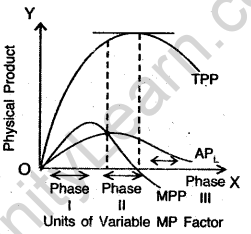
Or
Give the meaning of price elasticity of demand. Explain the relationship between it and total expenditure.
Answer. Price elasticity of demand may be defined as the ratio of percentage change in the quantity demanded to percentage change in price of a commodity. In short, it is the degree of responsiveness of demand for a change in the price of a commodity. According to total expenditure the elasticity of demand will be as follows when price and total expenditure, change.
(i) If price and total expenditure move in opposite directions, elasticity of demand will be greater than 1.
(ii) If total expenditure remains the same whether price increases or decreases, elasticity of demand will be equal to 1.
(iii) If price and total expenditure change in the same direction, price elasticity of demand wiU be less than 1.
Question.12. State the different phases of returns to a factor in terms of total product. Represent the same on a diagram.
Answer. In the short run, units of variable factors change (or increase) for increasing the total product. In this context, three phases or situations can be possible. All the three phases have been exhibited in the given diagram. These are:
(i) In the beginning,4 when additional units of a variable
factor are employed, marginal product increases and Y total product also increases. This is phase I. I st phase ends where AP is highest or from where MP starts declining;
(ii) After this point, marginal product of the additional units of variable factor employed will start declining.
Therefore, total product increases but at a decreasing rate. This is phase II.
(iii) If additional units of variable factor are still used, marginal product becomes negative and hence total product starts declining. This is phase III.
A producer always operates in the second stage. ‘
For Blind Candidates only in lieu of Q. No. 12 State the different phases of returns to a factor in terms of total product. Represent the same in a schedule.
Answer. Read the answer to the above Q.12.
Question.13. The price of a commodity is 110 per unit and total revenue from it is Rs 1,000. Its price elasticity of supply is 0.8. Its price falls by 10 percent. Calculate the total revenue at the reduced price.
Answer.
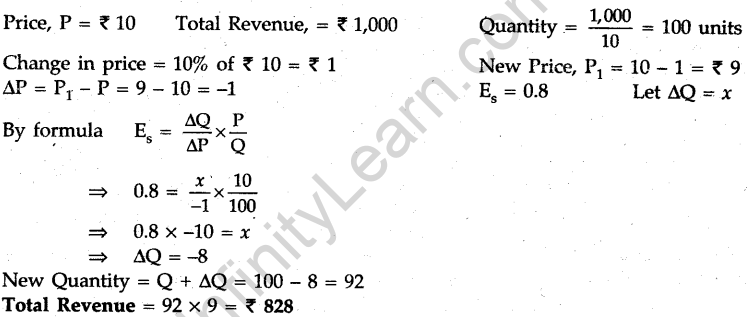
Question.14. Giving reasons, state whether the following statements are true or false:
(i) Marginal utility can never be negative. .
(ii) A budget set is the collection of all bundles of goods that a consumer wants to buy.
(iii) The demand for a commodity always increases with increase in the price of other goods.
Answer. (i) The statement is false. Marginal utility can be negative also. Marginal utility keeps on declining on using additional units of a commodity successively. Therefore if we go on using additional units, a stage comes, when marginal utility becomes zero and then negative.
(ii) The statement is false. The set of bundles of two goods that are available to a consumer is a budget set. This signifies that the bundles constituting budget set are available to the consumer and does not mean that these are the bundles which consumer wants to buy.
(iii) The statement is false. Increase in the prices of other goods leads to an increase in the demand for a commodity but not always.
Question.15. Complete the following table:

Answer. Total Fixed Cost = AFC x No. of Units = 18 x 4 = Rs 72

Question.16. Explain the sequence of changes that will take place when there is excess demand of a commodity.
Answer. There will be excess demand of a commodity when price is less than the equilibrium price. In the given diagram, OP is the equilibrium price where quantity demanded and supplied are equal. However, when price is reduced to OP1, demand exceeds supply, with the result that there is excess demand = Q2Q1 In such a case the demand should be reduced and supply increased. So that both these may be equal. These would be equal, when price is increased from OP1 to OP, where quantity demanded and supplied are equal.

Or
X and Y are complementary goods. Explain the sequence of effects of a fall in the price of X on the equilibrium price and quantity of Y.
Answer. X and Y are complementary goods. This means both goods are demanded simultaneously. In other words, X cannot be used without Y and Y cannot be used without X. If the price of X falls, its demand will increase because of the application of law of demand.
When demand of X increases, demand of Y will also increase, with the result that there will be a rightward shift in the demand curve of Y.
As a result of this, the equilibrium point will shift to the right from E to F, where price increases from OP to OP1 and demand increases from OQ to OQ1
Therefore, as a result of fall in the price of X, the equilibrium price and quantity of commodity Y both increase. This is clear from the diagrams given below.

SECTION B
Question.17. Define domestic product.
Answer. Domestic product is the value of final goods and services produced within the domestic territory of a country in an accounting year
Question.18. What is transfer payment?
Answer. Transfer payments are unilateral payments which recipients get without adding anything to the current flow of goods and services.
Question.19. What are demand deposits?
Answer. Demand deposits are those bank deposits which can be withdrawn by the depositors whenever they want.
Question.20. How is primary deficit calculated?
Answer. Primary deficit is the difference of fiscal deficit and interest payments .
Primary Deficit = Fiscal Deficit – Interest Payment.
Question.21. What is meant by cash reserve ratio?
Answer. Cash Reserve Ratio (CRR) is the portion of total deposits which commercial banks are required to keep as reserve with the central bank of the country.
Question.22. From the following data calculate “net value added at factor cost”:

Answer.

Question.23. Explain the relationship between average propensity to consume and average propensity to save. Which of these can have a negative value and when?
Answer. Average Propensity to Consume (APC) is the ratio of total consumption expenditure to total income. Average Propensity to Save (APS) is the ratio of total savings to total income. In short,

Question.24. Explain the meaning and implications of revenue deficit.
Answer. See Q. 29, 2008 (I Outside Delhi)
Question.25. In an economy aggregate demand is less than aggregate supply. Explain the changes that will take place in this economy.
Answer. It is a scenario where aggregate demand is smaller than aggregate supply if equilibrium is reached before the full employment level of output. As demonstrated by EF in the accompanying diagram, the gap between the two is a deflationary gap.
This discrepancy can be closed by raising aggregate demand. In this circumstance, self-investment should be enhanced. A diagram can be used to illustrate this problem.
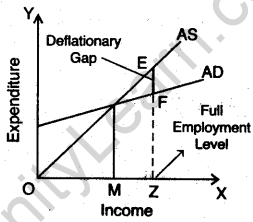
Or
Explain the meaning and implications of deflationary gap.
Answer. A condition of insufficient demand occurs when aggregate demand and aggregate supply are in equilibrium at a level of output that is less than full employment.
This occurs when the economy’s aggregate demand is insufficient to provide a level of output that can provide employment to all those who want to work.
At full employment, aggregate demand falls short of aggregate supply by a certain amount, resulting in a deflationary gap. The magnitude of demand deficiency (deflationary gap, EF) at full employment is seen in the diagram below.
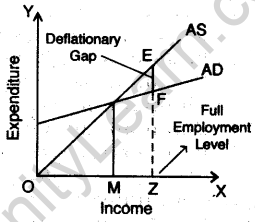
Question.26. Explain why there is a rise in demand for foreign exchange when its price falls.
Answer. See Q. 23, 2008 (I Outside Delhi)
Question.27. How can distribution of income be a limitation of using gross domestic product as an index of welfare? Explain.
Answer. The distribution of the rise in national income remains to be seen. When national income rises, individual income does not have to rise in the same proportion. Individual salaries may increase in a variety of ways. It may fall in some instances. To put it another way, disparities may worsen. Increased income disparities may have a negative impact on society’s economic well-being. As a result, it is necessary to determine whether an increase in national income increases or decreases income inequalities in order to determine the effect of increased national income.
Or
Giving reason, categories the following into stocks and flows:
(i) Profits (ii) Capital (iii) Savings (iv) Balance in a bank account
Answer. (i) Profits are flows because they relate to a period of time.
(ii) Capital is a stock as it relates to a point of time.
(iii) Savings are flows as they relate to a period of time.
(iv) Balance in a bank account is a stock as it relates to a point of time.
Question.28. Distinguish between revenue receipts and capital receipts. Give two examples of each.
Answer. Revenue Receipts: A revenue reception is one that does not result in the creation of a liability or a decrease in the value of assets. Tax revenue, such as income tax, and non-tax revenue, such as fees and fines, are examples of revenue receipts.
Capital Receipts: Capital receipts are those that the government receives as a result of incurring liabilities or selling assets. Its examples include raising funds through public loans. The government may also be able to raise funds through disinvestment, such as the sale of a public-sector unit. These are some examples of government receipts.
There is no responsibility in the case of revenue receipts, but a liability is formed or an asset is sold in the case of capital receipts.
Question.29. Giving reasons, state whether the following statements are true or false:
(i) Current account of Balance of Payments account records only exports and imports of goods and services.
(ii) Foreign investments are recorded in the capital account of balance of payments.
Answer. (i) The statement is false. In current account of balance of payments, besides recording export and import of services, unilateral receipts and payments are also included.
(ii) The statement is true. Foreign investments are recorded in the capital account of balance of payments.
Question.30. How is “bank rate” used by central bank in influencing credit creation by commercial banks? Explain.
Answer. Bank rate is the rate at which central bank discounts first class bills and securities of the commercial banks. In other words, the rate of interest which a central bank charges from the commercial banks, to give them credit can be called as bank rate.
(i) When bank rate is higher, commercial banks will charge higher rate of interest from their customers. Therefore, when bank rate increases, rate of interest on loans will also be more and so credit becomes expensive and the demand for credit is reduced. This . results in credit control.
(ii) With decrease in bank rate, interest rate on loans is also decreased, 50 credit becomes cheap and demand for credit increases. It is called credit expansion. ,
In short, bank rate and volume of credit are inversely related and the effects of changes in the bank rate on the volume of credit is brought about through the changes in the rate of interest.
Or
How does money overcome the problems of barter system? Explain briefly.
Answer. Money overcomes the problems of barter system by the following functions:
Medium of exchange: It means that money acts as an intermediary for the exchange of goods and services. It has helped a lot in promoting trade among people and countries. Money has removed the difficulty of double coincidence of wants.
Measure of value: Money serves as a measure of value. All the goods and services have their prices. This helps in measuring the exchange values of commodities. So value of all goods can be expressed in terms of money.
Standard of deferred payment: The value of money is more stable in comparison to the value of other commodities. It has general acceptability also. It is more durable as compared to other commodities.
Store of value: Money serves as a store of value because it can be stored without loss in its value and it is also convenient to store. Moreover, goods are perishable, whereas money is not perishable in the same sense.
Question.31. Explain the steps taken in derivation of the Consumption Curve from the Saving Curve.Use diagram.
Answer. Total income is the sum of = Consumption Expenditure + Saving. Consumption is the function of income. However, some consumption is always there even if there is no income i.e. zero level of income. This is called as autonomous consumption. Saving is that part of income which is not consumed. Therefore, if we subtract consumption from income, we get saving. When consumption is greater than income, saving is negative when consumption and income are equal, saving is zero; when consumption is less than income, saving is positive.
If we subtract consumption from income, we get saving. In the same way, if we subtract saving from income, we get consumption. In short,
Saving Income – Consumption , Consumption = Income – Saving Thus consumption and saving function can be stated as below: Y C = a + c Y S = a + cY.
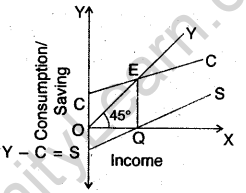
In the diagram, CC is consumption curve. OY is 45° line. E is the point of intersection where consumption and income are equal. At this level, saving is equal to zero. Up to OQ level of income, consumption is greater than income and therefore saving is negative. Beyond OQ level of income, consumption is less than income and therefore saving is positive. Because of this SS saving curve does not start from the point of origin but from the point S.
For Blind Candidates only in lieu of Q. No. 31.
Explain the steps taken in deriving the consumption function from the Saving function.
Answer. Same Answer…
Question.32. Calculate: (i) GroSs National Product at Market Price and (ii) Net National Disposable Income from the following data:


Answer.
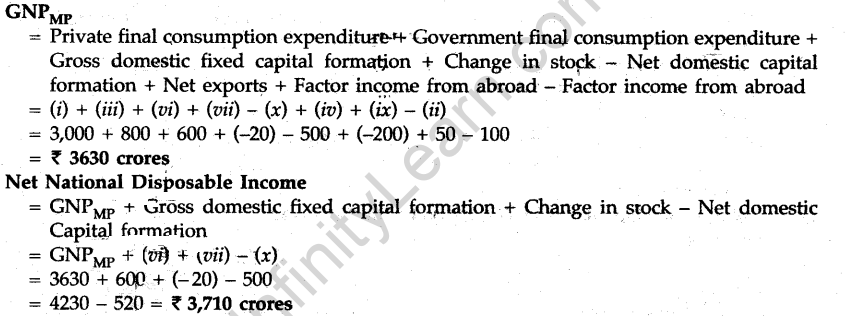
SET II
Note : Except for the following questions, all the remaining questions have been asked in Set I.
SECTION A
Question.8. Explain the effect of rise in income of the buyers of a commodity on its demand.
Answer. When income of the buyers increases, they demand more quantity at the same price. As a result of this, there is a shift in demand curve towards the right. This phenomenon can be explained with the help of a diagram. As a result of increase in the income of buyers, the point of equilibrium, which was at E, shifts to F, where the, quantity demanded at price OP increases from OQ to OQ1.

Question.9. Explain any two features of monopoly.
Answer. The two features of monopoly are:
(i) There is a single seller of the commodity in the market.
The monopoly firm has full control over supply of the commodity.
(ii) There are no close substitutes of the commodity sold by the monopolist.
Question.13. When the price of a commodity falls from Rs 10 per unit to Rs 9 per unit, total revenue from it falls from Rs 1,200 to Rs 918. Calculate its elasticity of supply.
Answer.

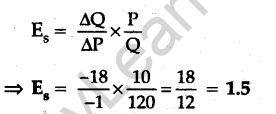
Question.15. Complete the following table:

Answer. Total Fixed Cost = AFC x No. of Units = 18 x 5 = Rs 90

SECTION B
Question.17. Define intermediate goods.
Answer. Intermediate goods are those which are used during the production process. These goods are not included in the estimation of national income.
Question.21. Define money.
Answer. Money may be defined as anything which is used as a medium of exchange and has general acceptability.
Question.24.Distinguish between direct tax and indirect tax.
Answer. Direct Tax: When the liability to pay a tax and the burden of that tax falls on the same person, the tax is called a direct tax. The burden cannot be shifted on others. For example, Income tax. Indirect Tax: When the liability to pay a tax is on one person and the burden of it falls on another person, it is called an indirect tax.’The burden of such a tax is shifted others. For example, series tax.
Question.26. Give the meaning of foreign exchange rate. How is it determined under flexible exchange rate regime?
Answer. The rate of exchange is the rate at which a country’s currency is exchanged for another currency. Exchange rates can be fixed or variable. A fixed exchange rate is one in which the country’s government has purposefully set the currency rate. Flexible exchange rates, on the other hand, are determined by the forces of demand and supply for foreign exchange. Exchange rates are more variable these days.
The demand for a foreign currency and its price in domestic currency have an inverse connection. On the other hand, there is a direct correlation between a foreign currency’s file supply and its price in home currency.
The equilibrium exchange rate is determined at a point where demand for and supply of foreign currency is equal. As shown in the diagram, the exchange rate will be OP because at this level the demand for and supply of foreign currency is equal.
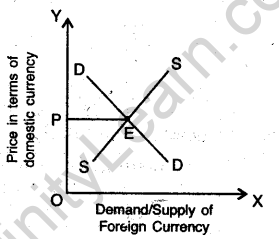
SET III
Note : Except for the following questions, all the remaining questions have been asked in Set I and Set II.
SECTION A
Question.6. Explain the problem of ‘what to produce’
Answer. The ‘what to produce’ problem refers to the goods that should be produced and in what quantities. This dilemma develops when we are unable to produce all we desire owing to a limitation of resources. As a result, a decision must be made on what commodities and in what quantities should be produced. In other words, we need to decide whether we should develop consumer products, production goods, defence goods, or a mix of the three. As a result, an economy must select which items should be produced and in what amounts based on the relevance of particular goods.
Question.9. Explain the implication of the product differentiation feature of monopolistic competition.
Answer. Different producers establish artificial variations in the product under monopolistic competition on the basis of size, packing, brand name, colour, amount, scent, and other factors. These distinctions are made in order to position the product as a distinct product in the eyes of consumers. Product differentiation can be seen in toothpaste brands like as Colgate, Meswak, and Pepsodent. Because of product differentiation, a manufacturer does not lose all of his customers if he raises the price of his product. On the other hand, lowering the price of his goods has no effect on the number of consumers who buy it.
Question.13. From the following data, calculate elasticity of supply:

Answer.
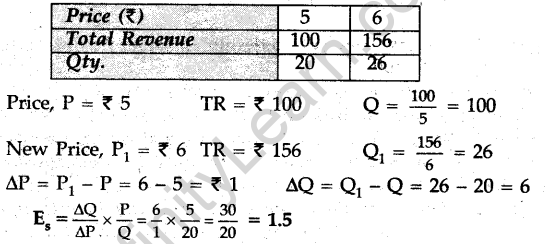
Question.16. Complete the following table:

Answer. Fixed cost = AFC x No. of units = 6×5= Rs 30

SECTION B
Question.17. Define capital goods.
Answer. Capital goods are those goods that form the capital stock of a country at the end of an accounting year and which are used in the production process.
Question.21. What is the statutory liquidity ratio?
Answer. Statutory liquidity ratio is the proportion 6f total deposits that commercial banks are legally required to keep with them.
Question.24. Distinguish between revenue expenditure and capital expenditure with one example of each.
Answer. Revenue Expenditure: It is the expenditure of a government that does not create any asset nor reduces liabilities. Its example is the salaries of employees.
Capital Expenditure: An expenditure which results in the creation of assets or reduction in liability, such as construction of roads and bridges.
Question.26. Explain why is there a direct relationship between price and supply of a foreign currency.
Answer. The price of a foreign currency and its supply are inextricably linked. As a result, as the price of a foreign currency rises, so does its supply, and when the price falls, so does the supply. When the value of a foreign currency falls, so does demand. Naturally, more foreign money will be required to purchase foreign goods, resulting in a decrease in foreign currency availability. On the other hand, if the price of a foreign currency rises, so does its supply.
Question.30. Calculate: (i) Net Domestic Product at Factor Cost and (ii) Gross National Disposable Income from the following data:


Answer.






